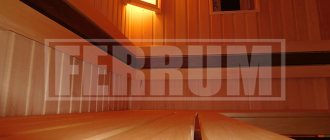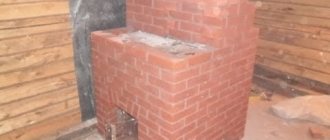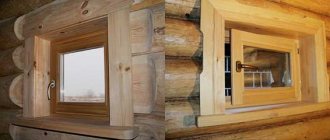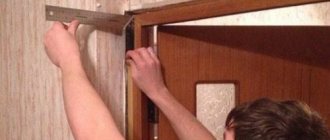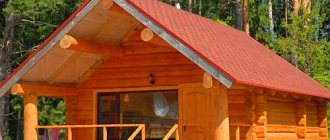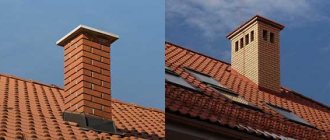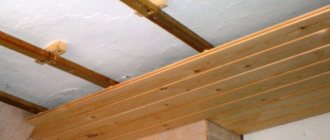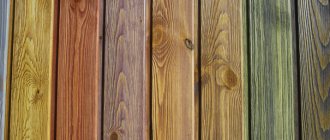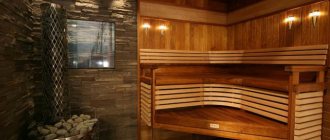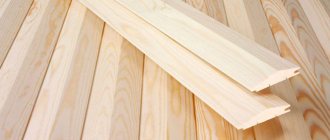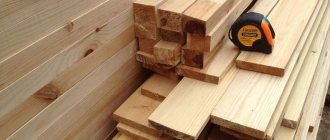The unique atmosphere of pampering and health that reigns in the bathhouse does not leave a single person indifferent. And covering this room with high-quality material is one of the important points in construction.
Most often, baths are lined with wooden clapboard. When choosing lining for finishing a steam room in a bathhouse, take into account all the properties of the wood from which the material is made.
One of the most used types of wood for finishing the steam room of a bathhouse is lining made of linden wood. Let's figure out why. What are the pros and cons of this material?
How to decipher the manufacturer's inscription
We read the marking as follows:
- Sheathing brand (see details below)
- Type of lining (see table below)
- ThicknessxWidthxLength
- GOST
- Sometimes manufacturers indicate the number of pieces per package
An example of a symbol for eurolining:
Grade C 12.5×96(88)x2000 mm 10 pcs. in unitary enterprise Eurolining grade C, 12.5 mm thick, 96 mm thick, 2000 mm long. Pack of 10 pcs.
An example of a regular lining according to GOST:
O-3-13x120x4000-GOST 8242-88 This means - Sheathing grade O-3 13 mm thick, 120 mm wide, 4000 mm long, manufactured in accordance with GOST 8242-88.
Conversion of cubic capacity into pieces
First, let's estimate how much lining there is in a cube individually. The packaging usually indicates the parameters of an individual lamella. For example, they are equal to 16x150x6000. Dimensions are given in millimeters, which is not very convenient for calculation, so we convert to meters. It turns out that the thickness, usable width and length of the board are 0.016, 0.15 and 6 meters, respectively. We multiply the numbers and get the volume of one unit of lining of 0.0144 cubic meters. m. We divide 1 m3 by the result obtained and find that there are 69.44 lining boards per cubic meter. We round down and we can estimate how many cubes we need to purchase.
Wood paneling option
Dimensions of standard lining according to GOST
Classic lining, popularly known as “collective farmer”, is regulated by GOSTs with the name “cladding board” of the following sizes and sections:
Lining grade O-1
Lining grade O-2 (1st option)
Lining grade O-2 (2nd option)
Lining grade O-3 (1st option)
Lining grade O-3 (2nd option)
Lining grade O-4
It is made from various types of wood: pine, spruce (conifers are the cheapest), birch, alder, linden, aspen, ash, oak, larch, cedar.
Evolution has taken the dimensions of cladding boards beyond the limits established by state standards and today you can easily find products for sale in the following sizes: thickness from 12 to 25 mm; width—up to 150 mm; length - up to 6000 mm.
Beautiful examples
- Wooden lining looks organically combined with other finishing materials, as well as with household items.
- Modern designers successfully use lining in various styles. Naturally colored material is usually used.
- Modern styles can also include clapboard decorative elements. In this example, the lining plays the role of an ideal background for bright accessories.
- The following example looks like a good design option - the lining harmonizes perfectly with decorative stone and exquisite ceramics.
For more useful information about lining sizes, see below.
Dimensions of eurolining
Manufactured according to Western European standard DIN 68126/86. The key difference from the domestic standard version discussed above is the presence of longitudinal ventilation grooves (see photo below this paragraph) on the reverse side, which work as stress compensators arising from changes in temperature and humidity, and also facilitate the removal of condensate due to air circulation.
Dimensions according to European standards: Thickness – 12.5-14-16-19-21 mm; Width – 80-100-110-120-138 mm; The thickness of the lining is calm for internal use - 12.5–16 mm, for external use - 18.5–22.5 mm. Length gradation at the discretion of the manufacturer. Packaged in packs of 10 pcs.
Classes
Eurolining comes in four classes - Extra, A, B and C.
- Extra - high quality, without defects, noble color and almost perfect surface.
- “A” - contains knots and cracks (minor, small diameter).
- “B” - characterized by a higher content of cracks and knots.
- And finally, "S". The presence of wormholes and blue spots is allowed on the surface.
Types of wood from which they are made
It is made from different types of wood, so it can differ significantly in quality and, accordingly, in price.
One of the most inexpensive varieties is euro-lining made of pine. often chosen because of its low price and neutral color of wood , which allows you to give the product almost any shade with the help of aqualas.
The dimensions of eurolining made from pine are no different from standard products made from other raw materials.
But before purchasing this finishing material, you need to familiarize yourself with the properties of wood. This will allow you to determine which option is suitable for a particular type of premises.
Pine . It is not very resistant to moisture, harmful insects and temperature changes. However, with high-quality processing, it can be used for finishing balconies, facades, and stairs.
Linden and aspen . They are characterized by increased resistance to temperature changes and high humidity, and therefore can be used for finishing any type of premises and facades.
Larch . Not subject to rotting, excellent resistance to harmful insects. Even with prolonged use, it does not lose its original qualities - it retains its beautiful appearance and resistance to external factors.
I blow and ash .
Expensive, but beautiful and durable wood species, used mainly for interior decoration.
MDF lining
This type of lining is produced by pressing wood chips at high temperatures.
| Manufacturer | Length, cm | Width, mm | Thickness, mm |
| Kronospan | 260 | 200 | 14 |
| 260 | 325 | 9 | |
| 260 | 153 | 8 | |
| 260 | 200 | 7 | |
| 260 | 153 | 7 | |
| NDM | 130 | 198 | 6 |
| 260 | 198 | 6 | |
| Union | 260 | 238 | 7 |
Price policy
The cost of the lining is determined by its grade, size, wood used for production, and the shape of the lamella. If we take a length of 6 meters and category grade A as the initial installations, we can roughly estimate a cubic meter of cladding material. So:
- Ordinary lining, popularly called “collective farmer”. You will have to pay 300-500 rubles for a “square” if you agree to affordable wood species. The cedar “collective farmer” is the most expensive, you won’t find it for less than 1000.
- Calm made of alder or linden costs 450-600 rubles, for larch you will have to pay up to 750; cedar again turns out to be the most expensive - 900-1200 rubles.
- A block house (lining with a strongly convex outer surface and a tongue-and-groove system) will cost 250-500 rubles if the panels were made of alder or pine, 1000-1500 if larch or linden were used, and 2500 when purchasing cedar lining.
When buying lining for finishing a house, it is recommended to take 10 percent more than the estimate. You can save a little if you take the time to open each package and go through all the slats. In the middle of the pack there will probably be a defect that needs to be replaced with items that meet the paid standards.
Watch this video to know how to choose the right lining:
How many linings are there in a cube? A simple calculation method using the 5th grade math formula
From my own experience, I can say that for domestic needs, 1 m3 of lining is enough for about 75-80 m2; taking into account the cuts, it will be possible to cover about 70 m2 of “usable area”. Naturally, this dimensional guideline is very approximate and I recommend that you perform the necessary calculations yourself, taking into account your individual task.
Now you will see that it is very easy. Any search engine will kindly remind you of the formula for the volume of a rectangular parallelepiped from 5th grade mathematics:
Let our lining have dimensions: Width
85 mm , Thickness 18 mm , Length 3 m
. We calculate the volume of one board V1 = 0.018 m*0.085 m*3 m=0.00459 m3 Quantity in one cube, pcs N= 1/0.00459 = 218 pcs
Attention: In the calculations we use the “useful” width of the lining, without taking into account the size of the tongue-and-groove connection, as the lining boards will be packed end-to-end.
To calculate the area that we can cover with 1 m3 of lining, we calculate the area of one board S1 = 0.085 m * 3 m = 0.255 m2 Take the number of boards calculated above and multiply by the area of one board S = 218 pcs * 0.255 m2 = 56 m2
Subtract 10% for trimmings: 56 m2-6 m2 = 50 m2
In total, 1 cube of board measuring 85*18*3000 mm is enough to cover a wall with an area of 50 m2 .
Tips for choosing
The first piece of advice applies to the purchase of cladding boards of all classes and types: be careful, unfortunately, cases of deception are not so rare. Unscrupulous sellers, offering the buyer high-quality lining, replace the canvases inside the package with lower quality ones. Ask to see all items before purchasing. If the seller refuses to fulfill the stated condition, it is better to protect yourself and find another place to buy.
Advice on choosing a tree
Conifers, as already mentioned, are the most popular: the resin they contain has an antifungal effect and helps reduce humidity levels. Therefore, such boards are often used for exterior finishing of buildings.
Hardwood panels are suitable for interior cladding of ceilings and walls in a living room, bathroom or bathhouse. Such boards (aspen, linden or alder) are able to withstand humidity and high temperatures without heating up.
Hardwood linings do not contain resins, which will save you from worrying about the appearance of the finish when doing interior work.
Advice on choosing a class
Facades, balconies, walls of baths and saunas are objects for which cladding with class A wooden panels will be a suitable solution both in terms of functionality and in terms of presentable appearance.
Class C is only suitable for finishing utility buildings: sheds, garages, and so on.
“Extra” and B classes are used by everyone depending on the amount of funds allocated for the purchase of wood.
Any class and type of cladding wood will last a long time and live up to expectations. The main thing is to choose boards whose functions will meet the assigned tasks.
For example, A-class panels made of hardwood when covering the walls of a bathhouse or sauna will enhance the healing effect of staying in such a place. And thanks to “Extra” coniferous cladding boards, you won’t have to worry about the reliability and strength of the cladding - the facade of the house will be reliably protected.
Characteristics of wood
- The density of aspen is 500 kg/m3, this material is practical and beautiful.
- The wood in question is moisture resistant, which means a humid environment is not a problem for it. When aspen dries, it does not crack or deform in any way.
- It should be noted that the remarkable and practical quality of this material is that it does not rot. If this material is dried correctly, you can get very strong wood that has a high level of resistance to mechanical stress on it. Processing such material on a modern machine is very simple and easy.
Such properties have become the reason for the widespread use of aspen for interior decoration, especially in baths, steam rooms and saunas. Aspen lining can also be used to make various household items: shelves, chairs, tables, etc.
With a large number of advantages, this material also has some disadvantages, namely, in a mature tree of this type, a rotten core appears, therefore, wood aged no more than forty years is used for sale and finishing. Despite this disadvantage, the demand for aspen lining does not cease to grow.
White wood (aspen)
